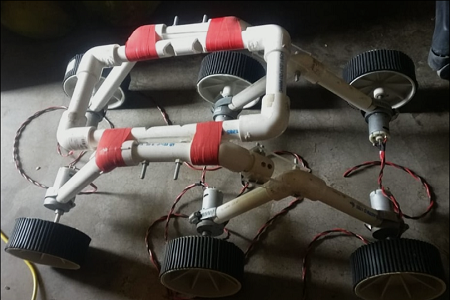


Indian Journal of Science and Technology
Year: 2021, Volume: 14, Issue: 25, Pages: 2119-2127
Original Article
Yogesh S Kale1,*, S V Rathkanthiwar2, Bhagyashree Sharma1, Janhavi Ghuguskar1, Kireet Deshmukh1, Rushikesh Kate1, Pranay Thakre1
Received Date:25 May 2021, Accepted Date:02 July 2021, Published Date:19 July 2021
Objective: The covid-19 outbreak affected the door-to-door delivery of essentials as it was difficult to maintain “physical distancing” causing a threat to the lives of people involved in the process. We aimed to design a fully autonomous vehicle that would be capable of moving over all types of terrains without any human intervention. Overall, the primary objectives of the vehicle are to be able to navigate to a given location, to be capable of moving over all terrains & climbing staircases, capable of detecting the hurdles and obstacles coming along the way and capable of carrying a payload. Method : The Raspberry Pi is the main control unit. Closed-loop feedback algorithm has been implemented. The direction and speed are controlled using the PID. The real time video is captured using the onboard camera. IMU sensors monitor the physical orientation of the vehicle. The battery provides required current and voltage to all the peripherals. Findings : In order to make sure that the bot is moving in a straight line and not deviating from the path required, line detection has been implemented. The image frames detected by the cameras are imported into Python in BGR color format which is later converted in HSV format. The upper and lower color limits are defined. Edge detection is done using Canny Transform and Line prediction requires Hough Line Transform. Novelty: This paper presented the mechanics and sensor system design of a small-sized and affordable, yet highly maneuverable all-terrain robot. The robot size can be altered according to its use. The project proved that an autonomous all-terrain robot can be designed and built with a relatively small budget. Because of the sensors and the processing unit, it was estimated that the chosen platform should be able to carry at least 3 kg of electronics.
Keywords
Navigate, Raspberry Pi, Line detection, Maneuverable, Sensors
© 2021 Kale et al. This is an open-access article distributed under the terms of the Creative Commons Attribution License, which permits unrestricted use, distribution, and reproduction in any medium, provided the original author and source are credited. Published By Indian Society for Education and Environment (iSee)
Subscribe now for latest articles and news.